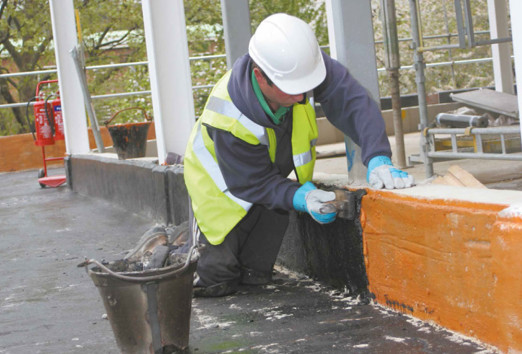Following on from our introduction to Mastic Asphalt, SIG Design & Technology explore when you might come across mastic asphalt and which types of roofing and other projects it should be considered for. We also outline three typical roof build-ups.
For listed buildings
Mastic asphalt roofing has an excellent reputation for reliability and durability compared to other waterproofing products, and this is one reason why it is often used in listed buildings. You will find it on the porches and box gutters of Georgian terraces, and on the roofs of stately homes, churches and cathedrals.
For Council buildings, access decks and bridges
Local authorities have a long-standing relationship with mastic asphalt. You’ll find it on civic centres and guildhalls, but also on the access decks of flats in housing estates. Local Authorities in London use it extensively to waterproof their buildings. You’ll also see mastic asphalt used for car park decks.
Tanking, lift pits and basements
Mastic asphalt is also commonly used for tanking in basements, lift pits and other underground areas. The membrane is resistant to water penetration and will not degrade. For such applications one would use a tanking grade asphalt product.
Typical mastic asphalt roofing build-ups
IKO’s Permaphalt polymer modified mastic asphalt product is suitable for mastic asphalt walkways, insulated warm roofs, un-insulated cold roofs and inverted/green roof configurations. The most common specified is the warm roof.
Warm roof
A warm roof has the principle thermal insulation placed above the structural deck, but beneath the waterproofing layer. With this configuration:
- The roof must be laid to a minimum fall of 1:80 though 1:40 is preferred;
- The build-up is commonly finished with a solar reflective paint finish or chippings;
- A separate vapour control layer is required;
- The structural deck can be concrete (in situ or precast), timber or metal decking (with continuous support).
Inverted roof in mastic asphalt
In the inverted roof configuration the insulation is located above the roofing membrane, acting as a protective layer. With this configuration:
- The insulation acts as a protective layer to the Permaphalt membrane
- The Permaphalt and structure are protected against extreme thermal changes during winter and summer months, giving considerable thermal stability to the system
- No separate vapour control layer is required
- Drainage falls may be omitted
- The system forms an ideal specification for insulated balconies and rooftop terraces.
Full Bond Roof System
Permaphalt Fullbond is a fully bonded polymer modified mastic asphalt roof waterproofing system for concrete decks. With this configuration alongside the inverted roof benefits:
- A torch-on underlay is fully bonded to the concrete structure
- Lateral tracking of moisture directly beneath the waterproofing is eliminated,
- The system is BBA certified
- Fire Performance achieving BS 476: Part 3: FAA
- Fullbond is suitable for inverted flat roofs, completely flat decks, podiums, green roofs and roof gardens.


